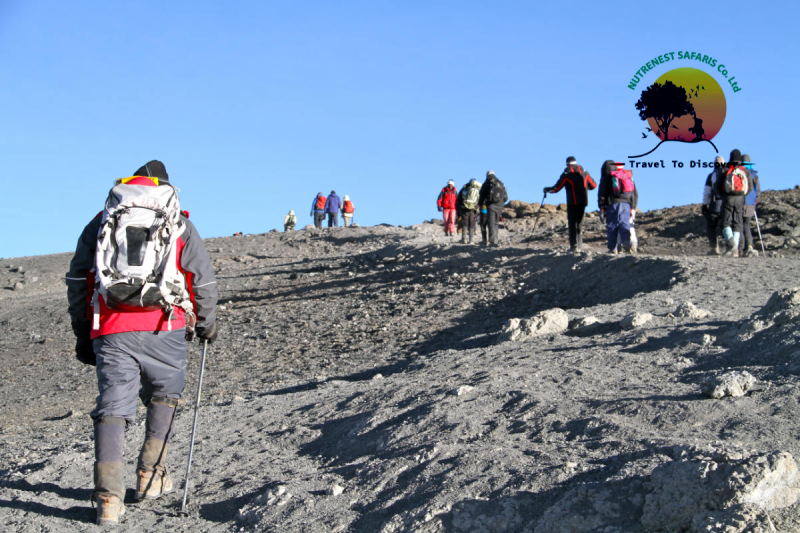The Umbwe Route Itinerary
The following itinerary is for six days although Umbwe can be done in five. This will help you acclimatize properly and give you the greatest chance of reaching the summit. In most cases, that will mean stopping at Karanga Campsite at the end of the third day. On this trail you head via Barafu Huts and Stella Point to the summit. For a true adventure, you can use the Western Breach to the summit
Day 1: Umbwe Gate To Umbwe Cave Campsite
It’s easy to wallow in the splendid tranquility of this route. But trekkers also find the first day quite tasking. Because the movement under Kilimanjaro’s humid forest canopy can be a bit of a sweat-fest. Along this route, there are plenty of features to attract your attention as you trek. Some beautiful plants, massive trees and a good chance of seeing some primates for example; Colobus and blue monkeys calling from the branches above.to mention but a few. You will come across one of the campsites on the trail which is the wonderful Umbwe Cave that is found deep in the forest
Day 2: Umbwe Cave Campsite To Barranco Huts
After take a cap of tea this morning, it’s only a matter of minutes before the forest starts thinning out and you enter into the heath and moorland zone. It’s really a lovely morning, with fantastic views down to the valleys on both sides. Some of Kilimanjaro’s most famous plants, including the alien-looking senecio and lobelia, now decorate the trail as you continue with your climb. The gorgeous views continue all around – including, for the first time, the Kibo summit itself.
Continuing upto the southern slopes, for virtually the first time on the entire trek, the path actually drops for a few minutes. It does this as it winds up its way round to the Barranco Campsite (3986m), many people’s favourite on the entire mountain
Day 3: Barranco Camp To Karanga Valley
Today is a short day of only three to four hours. Having this short day is actually very wise and good reason being you need to make sure you have fully relaxed in order to prepare yourselves for an extra long day for the following day. More so, you need to give yourselves as much time as possible to acclimatize because participating in the final climb to the summit tomorrow night, at the end of day 4, rather than tonight, could be the difference between getting to the summit or failure to reach the summit.
At the risk of sounding melodramatic, it could also mean the difference between surviving the trek or not surviving. At the summit of the wall the path drifts and meanders gently down to the Karanga Valley a gorgeous little place where malachite sunbirds flit from flower to flower. Both lunch and dinner are served at this campsite
Day 4: Karanga Valley To Barafu Camp
On a six-day itinerary this fourth day is similar to the previous one. It’s a short walk of three hours or so as you continue your traverse of Kibo’s southern side. You will hike through a spectacular lunar landscape on your way to Barafu Camp (4662m), on the south-eastern shoulder of Kibo. Here you will have a relaxation, take lunch and dinner, and try to get some sleep before the rigours of the night ahead of you
Day 5: Barafu Camp To Summit And Descent To Mweka Huts/Campsite
Arising at around midnight, begin your slow trek up to Stella Point (5745m) on the edge of the Kibo crater. It’s a steep, slow, cold trek and a test of your endurance. Never the less, this is where you earn your Kilimanjaro certificate, so try to keep on and keep on until you reach the summit. Provided you have avoided altitude sickness and have acclimatized well, there is no reason why you shouldn’t make it up to Stella Point. Here you reach, all being well at around 5am, though it can be much later depending on our condition.
From Stella Point it is a mere 45 minutes further on, past glaciers and snowfields and with views over the Kibo Crater, to Uhuru Peak. At around 5895m, this is the highest point in Africa. If you are on time, you can watch the sunrise over the African continent, take photos, and also take a breathe.
After a rest at the top, we continue back down to Barafu Camp – a walk that is considerably quicker than it was on the way up! At Barafu, take breakfast and relax for an hour, before continuing you trekking down the mountain, this time on the Mweka Trail. The rest of this day’s walk takes you back down through the alpine desert, heath and moorland zones until you once more enter the forest zone via Millennium Camp (3827m).
Throughout the trees, you find the Mweka Campsite (3106m), which is your final stop on the trek. Without any hindrance, you should arrive there at about 4pm and you have been walking for around 16 hours with little breaks. Exhausting but, if you made it to the top, oh yes, you will think it was worth it
Day 6: Mweka Camp to Mweka Gate
It’s just a couple of hours further now from the campsite to Mweka Gate (c1633m), where those who made it to the summit or Stella Point will collect their certificates. A car will be waiting to take you back to your place of accommodation, and a land of warm showers and cold beers thus that’s the end of your trek
